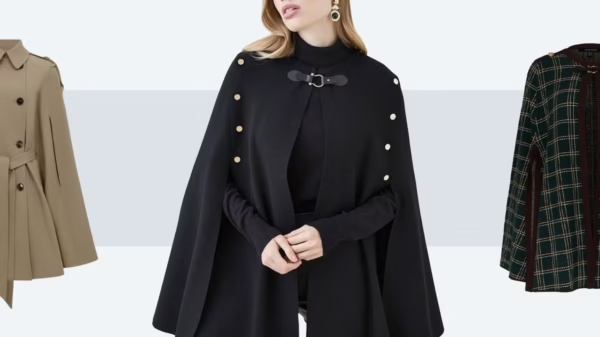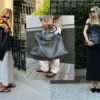Introduction to Sculptural Nail Art
Sculptural nail art is experiencing a remarkable surge in popularity within the beauty industry. This innovative approach elevates traditional nail designs from simple, flat patterns to intricate, three-dimensional sculptures, transforming nails into miniature works of art. This trend, which involves meticulous craftsmanship and boundless creativity, has captivated a broad audience and gained significant traction in recent years.
The evolution from basic nail designs to more elaborate, sculptural art is in part due to the increasing desire for individual expression and the pursuit of unique styling options. Sculptural nail art is not confined to merely painting nails but involves constructing raised designs, adding texture, and sometimes even incorporating elements like jewels, beads, and other adornments. These elaborate creations offer a fresh, dynamic way to accessorize and personalize one’s look, setting new standards in nail aesthetics.
This burgeoning trend has found favor not only among beauty enthusiasts but also within the realms of celebrity culture and high fashion. Celebrities across the entertainment spectrum, from pop icons to renowned actresses, frequently showcase sculptural nails on red carpets and social media platforms, further fueling its popularity. Fashion designers and stylists have also embraced this art form, often incorporating striking nail designs into runway shows and editorial photoshoots to complement their creative visions.
As sculptural nail art continues to flourish, it symbolizes the broader trend toward more experimental and avant-garde forms of self-expression within the beauty industry. This movement, marked by a blend of fine artistry and personal flair, is revolutionizing how nails are perceived and celebrated. By pushing the boundaries of conventional nail art, this trend not only exemplifies the innovative spirit of today’s beauty landscape but also opens up new avenues for creative exploration and artistic ingenuity.
Meet Juan Alvear: The Visionary Behind the Trend
Juan Alvear’s journey into the world of nail art is as unconventional as it is inspiring. Born and raised in New York City, Alvear’s early fascination with the arts led him to Cooper Union, one of the premier institutions for higher education in art, architecture, and engineering. It was here, amidst the rigorous training in fine arts, that Alvear developed a unique perspective that would later influence his transformative approach to nail art.
At Cooper Union, Alvear immersed himself in various art forms, drawing extensive inspiration from disciplines such as sculpture, painting, and conceptual art. This eclectic artistic background laid the groundwork for what would become his signature style in nail art—imaginative, boundary-pushing, and intricately detailed. His training ingrained in him a meticulous attention to detail and a fearless approach to innovation, elements that are palpably present in each of his creations.
Upon entering the nail art industry, Alvear quickly distinguished himself with his avant-garde designs. His early works were characterized by boldness and creativity, often incorporating unexpected materials and themes. Unlike traditional nail art that emphasized aesthetic prettiness, Alvear’s pieces were more akin to miniature sculptures, challenging preconceived notions of what nail art could be. It wasn’t long before his innovative approach garnered attention from both the public and industry insiders.
While initially met with curiosity and, at times, skepticism, Alvear’s work soon sparked a dialogue about the potential of nail art as a legitimate art form. His creations have since been featured in prominent fashion magazines and showcased in exhibitions, solidifying his reputation as a trailblazer in the field. Today, Juan Alvear continues to push the boundaries of nail art, transforming it from a beauty regimen into an expressive and impactful art form.
The Evolution of Alvear’s Nail Art
Juan Alvear’s journey in the world of nail art has been marked by a profound evolution in both technique and aesthetic. Alvear’s early work was characterized by chaotic, vibrant manicures that defied conventional standards of beauty. These initial creations, though labeled by some as ‘messy,’ were undeniably bold and innovative, setting the stage for his unique approach to nail artistry. His penchant for employing a medley of abstract doodles and large swatches of paint quickly distinguished his work from more traditional nail designs, resonating with those who appreciate avant-garde art forms.
Over time, Alvear’s techniques have undergone a transformation, merging his signature vibrant colors with a newfound sense of refinement and complexity. Rather than moving away from his roots, Alvear has built upon them, incorporating intricate details and nuanced textures into his designs. This evolution has allowed him to continually push the boundaries of nail art, transforming nails into miniature canvases that challenge conventional notions of both beauty and artistic expression.
A hallmark of Alvear’s style is his ability to blend vivid hues with dynamic patterns, achieving a harmonious balance between chaos and control. His use of vibrant colors is not merely for aesthetic impact but serves as a statement, inviting viewers to reconsider the potential and scope of nail art. Whether it’s through abstract compositions, experimental textures, or unconventional forms, each piece reflects his dedication to pushing creative limits.
Alvear’s work exemplifies the potential of nail art to transcend traditional definitions and enter the realm of high art. By embracing and refining his early, ‘messier’ techniques, he has successfully carved out a niche within the beauty industry. His evolving approach continues to inspire and challenge both artists and appreciators alike, fostering a deeper appreciation for the intricate and often overlooked art of nail design.
Inspiration and Creative Process
Juan Alvear, a celebrated nail artist, finds his inspiration in a myriad of sources, ranging from fine art, everyday objects, and pop culture. His unique approach to nail art is deeply rooted in his background as both a painter and a sculptor. This diverse artistic foundation enables him to infuse his nail designs with a distinctive sculptural quality that sets his work apart from conventional nail art.
Alvear’s creative process begins with a thorough exploration of visual stimuli. He often draws from classical and contemporary fine art, incorporating techniques and aesthetics from these disciplines into his nail designs. Everyday objects also fuel his creativity; mundane items can spark novel ideas, resulting in unexpected and innovative designs. Additionally, pop culture elements, such as themes from music, film, and fashion, frequently find their way into his work, making his nail art both current and culturally resonant.
The influence of his background as a painter is evident in his meticulous attention to detail and his keen sense of color. Alvear employs a painterly approach when applying pigment to nails, using a palette of vibrant hues and intricate patterns. His sculptural expertise is showcased through the three-dimensional aspects of his designs. By manipulating various materials, he constructs tiny, intricate sculptures that transform nails into miniature masterpieces.
The materials and tools Alvear uses are as varied as his sources of inspiration. He works with traditional nail art supplies, such as gel polish and acrylics, but also incorporates unconventional materials. Resins, metals, and even found objects can become integral components of his creations. His toolkit includes an array of specialized instruments, from fine brushes to sculpting tools, each chosen to execute precise and intricate details.
Through this blend of artistic influences and innovative techniques, Juan Alvear continues to push the boundaries of what nail art can be, offering a fresh, sculptural perspective that transcends the traditional bounds of the medium.
Sculptural Nail Art: Techniques and Materials
Sculptural nail art represents a fascinating intersection of creativity and technical finesse, pushing the boundaries of traditional manicure techniques. At the forefront of this innovative artistry is the utilization of 3D sculpting. This technique involves creating intricate designs that protrude from the nail surface, giving a multidimensional effect. Artists often use acrylics to mold various shapes and textures, ranging from delicate flowers to edgy geometric forms, achieving a raised, tactile quality that transforms nails into miniature sculptures.
Another prevalent method in sculptural nail art is layering. This technique progresses through the meticulously applied layers of gels or acrylics, building up thickness and forming complex patterns. Each layer is cured and shaped before the next is added, allowing for high precision and durability. This method not only enhances the visual depth of the nail art but also provides a sturdy base for more elaborate designs.
Embedding objects within the nails offers another avenue to explore creativity. Tiny trinkets or embellishments, such as crystals, miniature charms, and even dried flowers, are enclosed in layers of clear or tinted gels or acrylics. This encapsulation method results in a dramatic, eye-catching effect, as if the objects are floating within the nail itself.
The materials employed in sculptural nail art are as varied as the designs they create. Glow-in-the-dark polish is a popular choice, providing an unexpected pop of color in dim lighting and making the art even more dynamic. Custom-made embellishments, tailored to individual aesthetic desires, further personalize and elevate the artwork. Advanced nail artists like Juan Alvear often experiment with unconventional materials, staying ahead of trends and pushing the art form towards ever more imaginative horizons.
Acrylics remain a predominant material due to their versatility and durability. They offer a solid foundation for intricate designs and ensure the longevity of the sculptural art, making them indispensable in the artist’s toolkit.
The Impact of Sculptural Nail Art on Fashion and Beauty
The intersection of sculptural nail art with the fashion and beauty industry is becoming increasingly pronounced, marking a significant evolution in aesthetic expression. Led by visionary artists like Juan Alvear, the art form is not just confined to nails but extends into the broader spectrum of fashion and beauty, serving as both a complement and a statement piece.
Collaborations between nail artists and fashion designers are driving this trend forward. High-profile partnerships see sculptural nail art being integrated into designer collections, with each piece harmonizing with a designer’s vision. These collaborations frequently manifest at major fashion events, such as New York and Paris Fashion Weeks, where nail art isn’t merely an accessory but a key part of the overall look. Runway models flaunt intricate, tiny sculptures that resonate with the themes of the show, creating a cohesive and impactful presentation.
Red carpet appearances have also become a notable platform for exhibiting sculptural nail art. Celebrities sporting these avant-garde nail designs at premieres and award shows generate considerable buzz, embodying the fusion of haute couture and artistic craftsmanship. Seen as trendsetters, celebrities’ adoption of sculptural nail art facilitates its mainstream acceptance, influencing beauty norms and inspiring both professionals and enthusiasts within the industry to experiment with more daring designs.
Moreover, the influence of sculptural nail art extends to fashion editorials and advertising campaigns. Featured prominently in glossy spreads and digital media, these unique nail designs capture the viewer’s attention, adding a layer of visual interest that augments the narrative of fashion storytelling. This visibility underscores the growing importance of nail artistry as an integral aspect of fashion and beauty.
Ultimately, the integration of sculptural nail art within the fashion and beauty sectors signifies a broader acceptance and appreciation of this meticulous craft. It fosters innovation, encourages boldness, and sets new benchmarks for what is possible within the realms of personal style and artistic expression.
Challenges and Criticisms
Artists like Juan Alvear, who venture into the avant-garde realm of nail art, often face a range of challenges and criticisms. One of the most notable obstacles is balancing aesthetics with practicality. Nail designs that push the boundaries of traditional art can easily become cumbersome for daily activities. These sculptural masterpieces, while visually striking, might compromise the basic functionality that nails traditionally serve, such as typing, handling objects, or even simple tasks involving fine motor skills. This balance between art and usability is a persistent hurdle that every creative nail artist must navigate.
Critics also raise issues concerning the durability of intricate nail designs. Sculptural nail art, with its elaborate forms and delicate materials, is often perceived as fragile. The longevity of such art under typical wear and tear is questionable, posing a challenge for both the artist and the client. These factors bring into question the practicality of dedicating time and resources to ephemeral art that might not withstand the rigors of everyday life.
Societal perceptions of beauty further complicate the acceptance of extravagant nail art. Traditional beauty standards tend to favor simplicity and functionality, often viewing unconventional designs with skepticism or even disdain. Such biases impact the reception and appreciation of those like Alvear, whose work deliberately pushes boundaries. Society’s tendency to adhere to longstanding norms can stifle innovation and discourage bold experimentation in the realm of personal aesthetics.
In response to these challenges, Juan Alvear leverages his creativity to devise solutions that address these criticisms. By experimenting with durable materials and engineering design techniques that enhance the structural integrity of his nail art, he endeavors to extend the lifespan of his creations. Alvear’s innovative approach includes modular elements that allow parts of the design to be interchanged or repaired without compromising the whole piece. This adaptability speaks to a broader strategy of merging beauty with practicality. His work is a testament to the idea that art does not have to conform to rigid standards but can evolve to meet functional needs without losing its essence. Such visionary efforts not only counteract criticisms but also contribute to the expanding horizons of what nail art can achieve.
The Future of Sculptural Nail Art
The future of sculptural nail art promises to be an exciting fusion of technology, innovation, and artistic expression. As the industry continues to evolve, we can expect to see advancements in both techniques and materials that will further expand the possibilities of this creative art form. Emerging technologies such as 3D printing and advanced polymers are likely to play a significant role in shaping the future trends of sculptural nail art, allowing artists to create more intricate and durable designs than ever before.
Juan Alvear, a visionary in the field, envisions a future where sculptural nail art transcends traditional boundaries, becoming a medium for storytelling and personal expression on a whole new level. He foresees the integration of interactive elements, such as motion sensors and LED lights, which could transform nails into dynamic, living pieces of art. This forward-thinking approach not only pushes the creative limits but also challenges conventional perceptions of nail art.
Additionally, sustainable and environmentally friendly materials are gaining traction and could revolutionize the nail art industry. With a growing awareness of environmental issues, artists are seeking out biodegradable or recycled materials to create their masterpieces. This shift not only reduces the environmental impact but also opens up new avenues for innovative design, as artists experiment with these novel substances.
Alvear’s commitment to continuous innovation sets a benchmark for aspiring nail artists. He plans to maintain his role as a trailblazer by embracing new technologies, educating fellow artists, and fostering a community that values creativity and experimentation. By hosting workshops, collaborating with other artists, and sharing his knowledge, Alvear aims to inspire others to explore the vast potential of sculptural nail art.
The future of sculptural nail art is bright, brimming with opportunities for creativity and innovation. As artists like Juan Alvear lead the way, pushing boundaries and embracing new advancements, we can anticipate a dynamic evolution in the art form, making it an integral part of contemporary artistic expression.



































